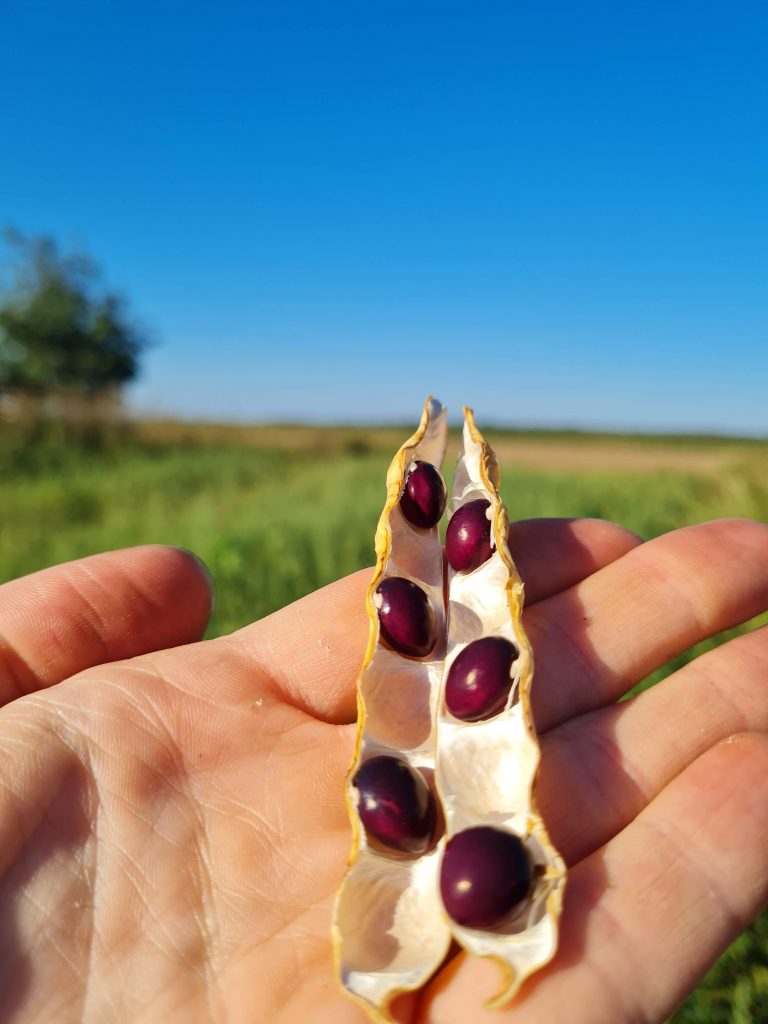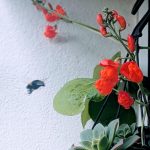The beauty in the seeds and further advantages of producing your own legume seeds
This article has also been published in German on the TerrABC platform, terrabc.org.
Legume seeds are living miracles

Picture © Nicolas Carton @lumineuses_div
The other day, I was looking at some beans before cooking them and I had an “aha-moment”: a plant had used the genetic information transmitted (and transformed) from generation to generation for thousands of years, to produce these small shiny and vaguely spheric miracles: seeds. Legume seeds are equipped with features to maximise their chances to produce healthy individuals that can in turn produce more seeds: a seed coat, strong enough to protect the inside, but permeable enough to allow rehydration of its contents, the cotyledons, reserves of energy and protein for the growth of the seedling, and a tiny sprout, which already contains the embryo of the main stem and first two leaves, but also the radicle.
They are perfect, because they are the result of thousands of generations of trials and errors. Our ancestors have taken advantage of the energy and protein reserves that the plants were producing for their “babies”: they became our food. By domesticating them, we made them unable to reproduce by themselves: a “modern” bean seed falling on the ground has very little chances to give a new healthy plant without the intervention of humans. They domesticated us as well, because we depend on them as much as they depend on us.
Legumes are a very easy plant family to learn to produce your own seeds
If you have a garden or even only a balcony, you can take part in the miracle of seed multiplication! It will contribute to maintaining a common heritage that has been developed over countless generations and that is fast disappearing, by reproducing your own seeds of heirloom varieties from one year to another.
At the Global Bean Project, we produced an information sheet on the multiplication of legume seeds. We also organised an online conference about legume seed saver initiatives throughout Europe and seed multiplication techniques. In this article, I give you a few basic tips, but do have a look at the information sheet for more details and per-species instructions.
Producing your own legume seeds is very easy because garden legumes are annual plants where the edible part is the pod or the seeds – they are “fruit vegetables”. In the case of carrots for instance, the edible part is harvested in the first year, but if you want seeds, you need to leave them one more year. In legumes, the methods to produce seeds are the same as the ones used routinely in the garden when producing vegetables from legumes (green peas, snow peas, green beans, edamame).
Only the end of the process will be different: to produce seeds, you need to leave the pods dry on the plants. The seeds are ready when they are hard, you can then harvest the pods open them and discard any bad-looking seeds. If you need to harvest the pods before they are completely dry (for instance because autumn is coming), let them dry in a ventilated place. These steps are very well illustrated for beans in a video made by the Ökologisches Bildungszentrum (ÖBZ) in München, from the Global Bean Show Garden series. You can then store the seeds in glass jars or in paper bags until next year. Freeze them for at least a week to control the infestation by weevils, insects of the bruchid family that may have laid eggs in the pods. Defrost slowly, the seeds will not lose germinating capacity. That’s it, you already have your seeds for next year!
Legumes are especially rewarding to multiply because they have relatively big, often beautiful seeds, where different varieties can be distinguished. This simplifies many steps of the process, like the cleaning of your seed harvest, compared with for instance salad, which has tiny seeds.
Picture: © Nicolas Carton @lumineuses_div.
Another reason why legumes are a good plant family if you’d like to start multiplying your seeds is that most legume species don’t outcross. For example, cucurbit seed production (pumpkins, zucchinis, melons, etc.) requires isolation of 2 km distance between varieties or species, otherwise they will mix their genetic information and may become something else, untasty. This is not required in most legumes, except for faba beans, which have a strong tendency to outcross. With most beans, the outcrossing rate is very low.
More good reasons to produce your own seeds
When you multiply seeds yourself, you have a cheaper (if not free) access to a wider range of varieties, as some are not available for sale but can only be found in seed saver’s initiatives (see links below). You then get many more chances to find some that you really love and that are adapted to you, be it for the taste, the way the plant grows or the decorative value.
Most modern varieties are bred for industrialised farming methods and are very homogeneous, whereas heirloom and local varieties often bear more within-variety diversity, which brings features more adapted to home gardens. For instance, the green beans of industrial bush bean varieties will nearly all be harvest-ready at the same time, while it may be better for your garden and kitchen if the harvest window is spread across several weeks, as in most older varieties.
Another great benefit is that the plants will adapt to your local conditions (soil, climate) over the course of a few generations and better resist changing local constraints. You can even create new varieties, applying your own criteria when selecting the seeds! For instance, saving the seeds from the first pods over the course of several generations should give you an earlier variety, saving only the biggest seeds should give you a variety with bigger seeds.
Finally, multiplying and exchanging seeds is also an act of civil disobedience against increasingly restrictive laws that enable the big seed companies to gain total control over this source of life.
Where to find interesting legume seeds?
At the Global bean Project, we created a collaborative table of seed sources where you can find were to get interesting legume varieties. Have a look and add your favourite seed dealers if they’re not yet on the table!
If you’d like to participate in multiplying programmes for the collective effort to preserve local, heirloom, rare varieties, get in touch with local associations in your own country. They are always looking for more volunteer multipliers! We know some in Germany, Switzerland, Austria, France, Albania, Spain, Sweden, Serbia, Greece, Portugal… Write to us if you know some in other countries !




